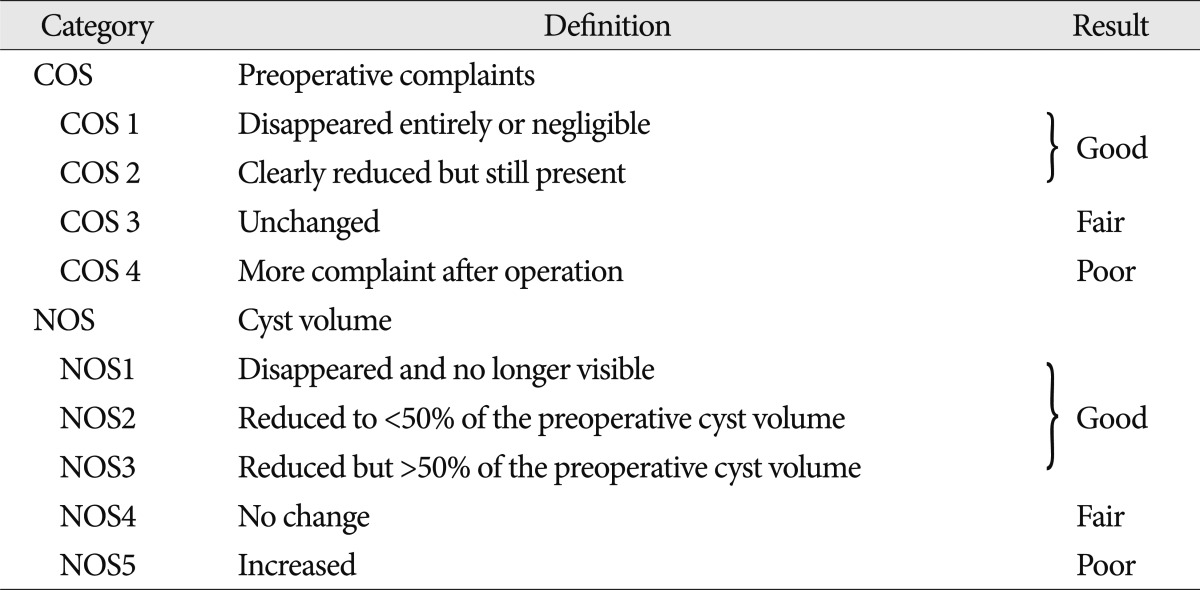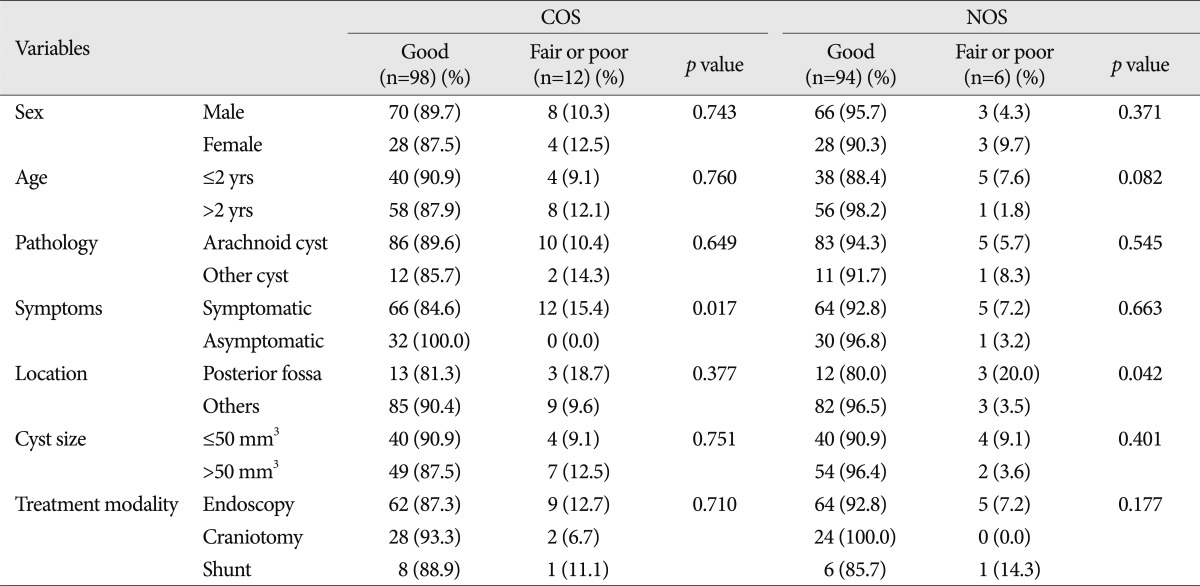1. Abbott R. The endoscopic management of arachnoidal cysts. Neurosurg Clin N Am. 2004; 15:9–17. PMID:
15062399.

2. Arai H, Sato K, Wachi A, Okuda O, Takeda N. Arachnoid cysts of the middle cranial fossa : experience with 77 patients who were treated with cystoperitoneal shunting. Neurosurgery. 1996; 39:1108–1112. discussion 1112-1113. PMID:
8938764.
3. Basaldella L, Orvieto E, Dei Tos AP, Della Barbera M, Valente M, Longatti P. Causes of arachnoid cyst development and expansion. Neurosurg Focus. 2007; 22:E4. PMID:
17608347.

4. Blakemore C, Garey LJ, Vital-Durand F. The physiological effects of monocular deprivation and their reversal in the monkey's visual cortex. J Physiol. 1978; 283:223–262. PMID:
102764.

5. Choi JU, Kim DS, Huh R. Endoscopic approach to arachnoid cyst. Childs Nerv Syst. 1999; 15:285–291. PMID:
10461776.

6. Cincu R, Agrawal A, Eiras J. Intracranial arachnoid cysts : current concepts and treatment alternatives. Clin Neurol Neurosurg. 2007; 109:837–843. PMID:
17764831.

7. Ciricillo SF, Cogen PH, Harsh GR, Edwards MS. Intracranial arachnoid cysts in children. A comparison of the effects of fenestration and shunting. J Neurosurg. 1991; 74:230–235. PMID:
1988593.

8. Czernicki T, Marchel A, Nowak A, Bojarski P. [Arachnoid cysts of the middle cranial fossa presented as subdural hematomas]. Neurol Neurochir Pol. 2005; 39:328–334. PMID:
16096939.
9. Daw NW, Wyatt HJ. Kittens reared in a unidirectional environment : evidence for a critical period. J Physiol. 1976; 257:155–170. PMID:
948048.

10. De Volder AG, Michel C, Thauvoy C, Willems G, Ferrière G. Brain glucose utilisation in acquired childhood aphasia associated with a sylvian arachnoid cyst : recovery after shunting as demonstrated by PET. J Neurol Neurosurg Psychiatry. 1994; 57:296–300. PMID:
7512624.

11. Di Rocco C, Tamburrini G. Shunt dependency in shunted arachnoid cyst : a reason to avoid shunting. Pediatr Neurosurg. 2003; 38:164. PMID:
12601243.

12. Di Rocco C, Tamburrini G, Caldarelli M, Velardi F, Santini P. [Prolonged ICP monitoring in children with sylvian fissure arachnoid cysts]. Minerva Pediatr. 2003; 55:583–591. PMID:
14676729.
13. Fewel ME, Levy ML, McComb JG. Surgical treatment of 95 children with 102 intracranial arachnoid cysts. Pediatr Neurosurg. 1996; 25:165–173. PMID:
9293543.

14. Galassi E, Gaist G, Giuliani G, Pozzati E. Arachnoid cysts of the middle cranial fossa : experience with 77 cases treated surgically. Acta Neurochir Suppl (Wien). 1988; 42:201–204. PMID:
3189009.
15. Gan YC, Connolly MB, Steinbok P. Epilepsy associated with a cerebellar arachnoid cyst : seizure control following fenestration of the cyst. Childs Nerv Syst. 2008; 24:125–134. PMID:
17680249.

16. Garcia-Bach M, Isamat F, Vila F. Intracranial arachnoid cysts in adults. Acta Neurochir Suppl (Wien). 1988; 42:205–209. PMID:
3189010.

17. Geissinger JD, Kohler WC, Robinson BW, Davis FM. Arachnoid cysts of the middle cranial fossa : surgical considerations. Surg Neurol. 1978; 10:27–33. PMID:
684602.
18. Grossman ML. Early child development in the context of mothering experiences. Child Psychiatry Hum Dev. 1975; 5:216–223. PMID:
1139979.

19. Harsh GR 4th, Edwards MS, Wilson CB. Intracranial arachnoid cysts in children. J Neurosurg. 1986; 64:835–842. PMID:
3701434.

20. Helland CA, Wester K. A population-based study of intracranial arachnoid cysts : clinical and neuroimaging outcomes following surgical cyst decompression in children. J Neurosurg. 2006; 105:385–390. PMID:
17328263.

21. Helland CA, Wester K. A population based study of intracranial arachnoid cysts : clinical and neuroimaging outcomes following surgical cyst decompression in adults. J Neurol Neurosurg Psychiatry. 2007; 78:1129–1135. PMID:
17299015.

22. Hund-Georgiadis M, Yves Von Cramon D, Kruggel F, Preul C. Do quiescent arachnoid cysts alter CNS functional organization? : A fMRI and morphometric study. Neurology. 2002; 59:1935–1939. PMID:
12499486.

23. Kandenwein JA, Richter HP, Börm W. Surgical therapy of symptomatic arachnoid cysts - an outcome analysis. Acta Neurochir (Wien). 2004; 146:1317–1322. discussion 1322. PMID:
15365792.

24. Karabatsou K, Hayhurst C, Buxton N, O'Brien DF, Mallucci CL. Endoscopic management of arachnoid cysts : an advancing technique. J Neurosurg. 2007; 106:455–462. PMID:
17566402.
25. Kobayashi E, Bonilha L, Li LM, Cendes F. Temporal lobe hypogenesis associated with arachnoid cyst in patients with epilepsy. Arq Neuropsiquiatr. 2003; 61:327–329. PMID:
12894261.

26. Kumagai M, Sakai N, Yamada H, Shinoda J, Nakashima T, Iwama T, et al. Postnatal development and enlargement of primary middle cranial fossa arachnoid cyst recognized on repeat CT scans. Childs Nerv Syst. 1986; 2:211–215. PMID:
3779685.

27. Kushen MC, Frim D. Placement of subdural electrode grids for seizure focus localization in patients with a large arachnoid cyst. Technical note. Neurosurg Focus. 2007; 22:E5. PMID:
17608348.
28. Levy ML, Wang M, Aryan HE, Yoo K, Meltzer H. Microsurgical keyhole approach for middle fossa arachnoid cyst fenestration. Neurosurgery. 2003; 53:1138–1144. discussion 1144-1145. PMID:
14580280.

29. Locatelli D, Bonfanti N, Sfogliarini R, Gajno TM, Pezzotta S. Arachnoid cysts : diagnosis and treatment. Childs Nerv Syst. 1987; 3:121–124. PMID:
3304624.
30. Lodrini S, Lasio G, Fornari M, Miglivacca F. Treatment of supratentorial primary arachnoid cysts. Acta Neurochir (Wien). 1985; 76:105–110. PMID:
4025013.

31. Marinov M, Undjian S, Wetzka P. An evaluation of the surgical treatment of intracranial arachnoid cysts in children. Childs Nerv Syst. 1989; 5:177–183. PMID:
2788033.

32. McBride LA, Winston KR, Freeman JE. Cystoventricular shunting of intracranial arachnoid cysts. Pediatr Neurosurg. 2003; 39:323–329. PMID:
14734867.

33. Morioka T, Kawamura T, Fukui K, Nishio S, Sasaki T. [Temporal lobe epilepsy associated with cystic lesion in the temporal lobe and middle cranial fossa]. No To Shinkei. 2003; 55:511–516. PMID:
12884803.
34. Nowosławska E, Polis L, Kaniewska D, Mikołajczyk W, Krawczyk J, Szymański W, et al. [A comparison of neuro-endoscopic techniques with other surgical procedures in the treatment of arachnoid cysts in children]. Neurol Neurochir Pol. 2003; 37:587–600. PMID:
14593754.
35. Nowosławska E, Polis L, Kaniewska D, Mikołajczyk W, Krawczyk J, Szymański W, et al. Neuroendoscopic techniques in the treatment of arachnoid cysts in children and comparison with other operative methods. Childs Nerv Syst. 2006; 22:599–604. PMID:
16550440.

36. Oberbauer RW, Haase J, Pucher R. Arachnoid cysts in children : a European co-operative study. Childs Nerv Syst. 1992; 8:281–286. PMID:
1394268.
37. Pradilla G, Jallo G. Arachnoid cysts : case series and review of the literature. Neurosurg Focus. 2007; 22:E7. PMID:
17608350.
38. Punzo A, Conforti R, Martiniello D, Scuotto A, Bernini FP, Cioffi FA. Surgical indications for intracranial arachnoid cysts. Neurochirurgia (Stuttg). 1992; 35:35–42. PMID:
1603216.

39. Raeder MB, Helland CA, Hugdahl K, Wester K. Arachnoid cysts cause cognitive deficits that improve after surgery. Neurology. 2005; 64:160–162. PMID:
15642927.

40. Raffel C, McComb JG. To shunt or to fenestrate : which is the best surgical treatment for arachnoid cysts in pediatric patients? Neurosurgery. 1988; 23:338–342. PMID:
3226511.

41. Samii M, Carvalho GA, Schuhmann MU, Matthies C. Arachnoid cysts of the posterior fossa. Surg Neurol. 1999; 51:376–382. PMID:
10199290.

42. Sato H, Sato N, Katayama S, Tamaki N, Matsumoto S. Effective shunt-independent treatment for primary middle fossa arachnoid cyst. Childs Nerv Syst. 1991; 7:375–381. PMID:
1794117.

43. Serlo W, von Wendt L, Heikkinen E, Saukkonen AL, Heikkinen E, Nystrom S. Shunting procedures in the management of intracranial cerebrospinal fluid cysts in infancy and childhood. Acta Neurochir (Wien). 1985; 76:111–116. PMID:
4025014.

44. Sgouros S, Chapman S. Congenital middle fossa arachnoid cysts may cause global brain ischaemia : a study with 99Tc-hexamethylpropyleneamineoxime single photon emission computerised tomography scans. Pediatr Neurosurg. 2001; 35:188–194. PMID:
11694796.

45. Spansdahl T, Solheim O. Quality of life in adult patients with primary intracranial arachnoid cysts. Acta Neurochir (Wien). 2007; 149:1025–1032. discussion 1032. PMID:
17728995.

46. Tamburrini G, D'Angelo L, Paternoster G, Massimi L, Caldarelli M, Di Rocco C. Endoscopic management of intra and paraventricular CSF cysts. Childs Nerv Syst. 2007; 23:645–651. PMID:
17415572.

47. Tamburrini G, Dal Fabbro M, Di Rocco C. Sylvian fissure arachnoid cysts : a survey on their diagnostic workout and practical management. Childs Nerv Syst. 2008; 24:593–604. PMID:
18305944.

48. Voormolen JH. Arachnoid cysts of the middle cranial fossa. Surgical management for headache. Clin Neurol Neurosurg. 1992; 94(Suppl):S176–S179. PMID:
1320504.
49. Wester K, Hugdahl K. Arachnoid cysts of the left temporal fossa : impaired preoperative cognition and postoperative improvement. J Neurol Neurosurg Psychiatry. 1995; 59:293–298. PMID:
7673959.

50. Wester K, Moen G. Documented growth of a temporal arachnoid cyst. J Neurol Neurosurg Psychiatry. 2000; 69:699–700. PMID:
11032639.

51. Zada G, Krieger MD, McNatt SA, Bowen I, McComb JG. Pathogenesis and treatment of intracranial arachnoid cysts in pediatric patients younger than 2 years of age. Neurosurg Focus. 2007; 22:E1. PMID:
17628896.










 PDF
PDF ePub
ePub Citation
Citation Print
Print





 XML Download
XML Download